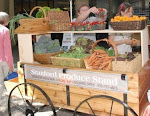Join us this Friday from 11 am to 3 pm for the Stanford Produce Stand! Come get your weekly supply of delicious, fresh, organic, and locally grown items. We are located in the front courtyard of Tresidder Memorial Union.
Instant Produce Stand Savings This Week!
Starting this week, spend $5 at the Produce Stand, and get an instant 5% off your purchase! Additionally, spend $10 or more and receive a 10% off coupon redeemable next Friday! Remember: If you received a 10% off coupon last week, be sure to stop by this week to redeem it!This Week at the Produce Stand
From the Stanford Community Farm and gardens: Leeks, bok choy, Chinese cabbage, rainbow chard, beets, green garlic, green onions, kale, turnips, and collards
From ALBA Organics: Avocados, strawberries, oranges, artichokes (for tips on how to cook and eat an artichoke, check out this website!), and salad mix
Spotlight on: Avocados!


Many have asked, and this week, we deliver. Avocados will be making their Spring Quarter debut at the Produce Stand this week! Who can resist avocados? They are rich, creamy, and just when you thought they couldn't possibly get better, it turns out they're GOOD for you! Contrary to popular belief, fats in the diet are essential for life. The key is getting the right kind of fat. Conveniently, avocados are a great source of the right kind. They're very high in monounsaturated fats, which have been shown to reduce heart disease by decreasing levels of LDL cholesterol (the bad stuff!) and increasing levels of HDL cholesterol (the good stuff!)
So what are you waiting for? Eat to good health with this recipe, adapted from Simply Recipes, for the "Perfect Guacamole."
Ingredients
2 ripe avocados
1/2 red onion (can substitute white onion instead)
1-2 serrano chiles, stems and seeds removed, minced (can substitute jalapeno peppers instead)
2 tablespoons cilantro leaves, finely chopped
1 tablespoon fresh lemon juice
1/2 teaspoon coarse salt
dash of freshly grated black pepper
1/2 ripe tomato, seeds and pulp removed, chopped
1. Cut avocados in half and remove seed. Scoop out avocado from the peel, put in a mixing bowl. (For tips on how to cut and peel an avocado, visit this link.)
2. Mash the avocado. (The mashing instrument of choice is up to you. Popular methods include: a fork, a potato masher, the back of a spoon, or even your hands.) Add the chopped onion, cilantro, lemon juice, salt, and pepper. Add the chili peppers/jalapenos gradually, and adjust according to your preference. (And be sure to exercise caution when handling peppers - keep those hands away from your eyes!) Keep the tomatoes separate until ready to serve.
3. Cover with plastic wrap and refrigerate until ready to serve. Mix in the chopped tomatoes just before serving.
Remember, feel free to experiment to find the taste profile that hits the right note for you. Some people prefer chunkier guacamole, while others like their avocado mashed up more. Some prefer more salt, others more spice. I prefer to add chopped up garlic and cheese as well. There is no one way to do it right, so taste and adjust as you go (or just keep tasting...).
To sum it all up: An instant 5% off when you spend $5 or more on a delicious selection of fresh, organic produce (not to mention those heart-healthy essential fatty acids)! What reason do you have not to stop by?
So what are you waiting for? Eat to good health with this recipe, adapted from Simply Recipes, for the "Perfect Guacamole."
Ingredients
2 ripe avocados
1/2 red onion (can substitute white onion instead)
1-2 serrano chiles, stems and seeds removed, minced (can substitute jalapeno peppers instead)
2 tablespoons cilantro leaves, finely chopped
1 tablespoon fresh lemon juice
1/2 teaspoon coarse salt
dash of freshly grated black pepper
1/2 ripe tomato, seeds and pulp removed, chopped
1. Cut avocados in half and remove seed. Scoop out avocado from the peel, put in a mixing bowl. (For tips on how to cut and peel an avocado, visit this link.)
2. Mash the avocado. (The mashing instrument of choice is up to you. Popular methods include: a fork, a potato masher, the back of a spoon, or even your hands.) Add the chopped onion, cilantro, lemon juice, salt, and pepper. Add the chili peppers/jalapenos gradually, and adjust according to your preference. (And be sure to exercise caution when handling peppers - keep those hands away from your eyes!) Keep the tomatoes separate until ready to serve.
3. Cover with plastic wrap and refrigerate until ready to serve. Mix in the chopped tomatoes just before serving.
Remember, feel free to experiment to find the taste profile that hits the right note for you. Some people prefer chunkier guacamole, while others like their avocado mashed up more. Some prefer more salt, others more spice. I prefer to add chopped up garlic and cheese as well. There is no one way to do it right, so taste and adjust as you go (or just keep tasting...).
To sum it all up: An instant 5% off when you spend $5 or more on a delicious selection of fresh, organic produce (not to mention those heart-healthy essential fatty acids)! What reason do you have not to stop by?
See you at the Produce Stand!
Photo credit: http://petitfoodie.wordpress.com














